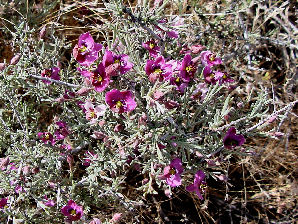Arizona Wild Flowers
Pictures, Photos, Images
Descriptions, Information, Reviews.
Range Ratany, Krameria parvifolia.
We Are Proud Of Our SafeSurf Rating!
| Range Ratany, Krameria parvifolia. Plant. Flowering Photos Taken April 29, 2003. Near Lake Pleasant, Arizona. |
|---|
 |  |
| Range Ratany Low, Grayish, Intricately Branched, Twiggy Shrub With Bilaterally Symmetrical Reddish-Lavender Flowers | Krameria erecta. (Krameria parvifolia). |
|---|---|
 | |
| Leaves: 1/4�1/2� (6�13 mm) Very Narrow, Grayish, Hairy, Reddish Prickles Each With Scattered Barbs Near Tip Height: 6�24�.) | Flowers: About 1/8� Wide, Each On Slender Stalk Bearing Many Gland-Tipped Hairs Sepals 5, Reddish Lavender Inside Upper 3 Petals Much Smaller Than Sepals Reddish Lavender, Joined At Base Lower 2 Petals Resembling Small, Greenish Pads Blooms March-October. |
 /
/

Range Ratany.
We wish to thank Wikipedia, the free encyclopedia for some of the information on this page. We share images and information with Wikipedia.
Ratany is a low growing, gray, intricately branched, twiggy shrub with bilaterally symmetrical reddish-lavender flowers. Ratany photosynthesize, but they also parasitize the roots of other plants. Thus, this species and others in its genus are root parasites, tapping the tissues of nearby plants for nutrients, especially water. This helps it survive in soil that is almost totally dry.These relationships and the hypothesis that range ratany obtains atmospheric moisture through its foliage may explain how it can maintain active growth after soil moisture has dropped below 3 percent. Ratany offer their bee pollinators oil instead of nectar. The oil bees (Centris) acquire nectar from other plants, but scrape off the oil from ratany to combine with pollen from other plants to feed their larvae. Range Ratany reproduces sexually by seed. In years with high soil moisture it will flower twice, in the spring and again in the fall. The root system is shallow, with 40 percent of the root mass in the top 4 inches of the soil, and spreads horizontally and radially. The Papago Indians used an infusion of the twigs externally for treating sore eyes and internally for dysentery. The roots provided them with a red dye for wool and other materials. The dye was also used as an ink. Range Ratany provides thermal cover for rattlesnakes (Crotalus spp.) and the western whiptail (Cnemidophorus tigris) [25]. Small mammals, such as the Bailey's pocket mouse (Perognathus baileyi), use Range Ratany for hiding cover. Range Ratany is an important forage species for all classes of livestock and for deer (Odocoileus spp.) It also provides cover for small mammals and reptiles. Palatability of Range Ratany is rated fair to good for cattle and sheep. Mule and white-tailed deer browse Range Ratany year-long with seasonal peaks. Mule deer peak use is from February to April and from August to October, and white-tailed deer peak use is from August to October. Range Ratany and White Ratany look almost the same. The flowers of White Ratany have a non-cupped bottom sepal and Range Ratany does not.
Quick Notes:
Height: Up To About 6 inches - 36 inches Tall.
Flowers: About 3/4� wide, each on a slender stalk bearing many gland-tipped hairs; sepals 5, reddish lavender inside; upper 3 petals much smaller than sepals, reddish lavender, joined awith green bases. lower 2 petals resembling small, greenish pads.
Stems: Stems are spineless but taper to a sharp point.
Flowering Time: Mid - March - October. But mainly Mid - March - May.
Fruit: Fruit is fuzzy greenish-white ball with reddish barbed spines. Range Ratany has barbs along the entire spines of the fruit..
Seeds: Seedpods 1 - 1 1/2" long, 3/8 - 1/2" in diameter; a cylindrical pod; short-pointed at ends, reddish; maturing in summer, remaining attached, often opening late; many elliptical flattened shiny brown; seeds.
Leaves: Leaves are inconspicuous, simple, smooth-edged to lobed, narrow, grayish-green, haired, about 1/4" - 1/2� long, very narrow, gray, hairy, reddish prickles, each with scattered barbs near tip.
Found: Native to southwestern United States, and northern Mexico.
Hardiness:
Soil pH requirements:
Sun Exposure:
Elevation: 0 - 5,000 Feet.
Habitat: Range Ratany's habitat is the desert environs, where it occupies open, sandy to rocky flats, bajadas, and playas. Creosote Bush Scrub, Joshua Tree Woodlands. An ideal xeriscape landscape plant in Arizona.
Miscellaneous: Flowering Photos Taken April 29, 2003. Near Lake Pleasant, Arizona.
|



We Are Proud Of Our SafeSurf Rating!
We Are Proud Of Our SafeSurf Rating!
Here Are Some Links To The Very Best & Most Popular Items Sold On Amazon.Com
To Learn More! Click The Links Below. No Obligation, Of Course!
| © 1966 - Present, Audrey, Eve, & George DeLange |


